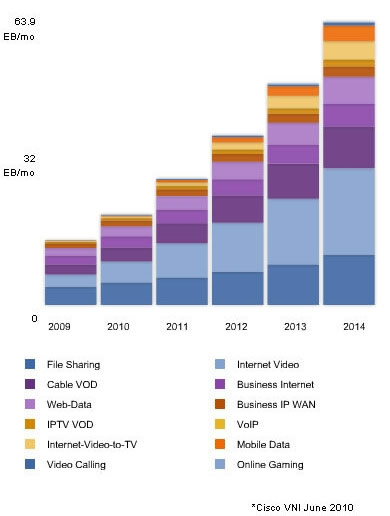
Global IP Traffic to Increase More Than Fourfold by 2014
Cisco's annual Cisco Visual Networking Index (VNI) Forecast, 2009-2014, projects that global Internet traffic will increase more than fourfold to 767 exabytes, or more than 3/4 of a Zettabyte, by 2014.
This amount is 100 exabytes higher than the projected level in 2013, or an increase the equivalent of 10 times all the traffic traversing Internet Protocol networks in 2008.
According to Cisco, the growth in traffic will continue to be dominated by video, exceeding 91 percent of global consumer IP traffic by 2014. Improvements in network bandwidth capacity and Internet speeds, along with the increasing popularity of HDTV and 3DTV are key factors expecting to quadruple IP traffic from 2009 to 2014.

Research Highlights:
Total Global IP Traffic in "Bytes"
- Global IP traffic is expected to increase more than fourfold (4.3 times) from 2009 to 2014, reaching 63.9 exabytes per month in 2014, up from approximately 56 exabytes per month in 2013. This is equivalent to 766.8 exabytes per year - almost three-quarters of a zettabyte, by 2014.
- The nearly 64 exabytes of global IP traffic per month projected for 2014 is equivalent to 16 billion DVDs; 21 trillion MP3's; or 399 quadrillion text messages.
Regional IP Traffic Trends
- By 2014, the highest IP-traffic generating regions will be North America (19.0 exabytes per month), Asia Pacific (17.4 exabytes per month), Western Europe (16.2 exabytes per month) and Japan (4.3 exabytes per month).
- The fastest growing IP-traffic regions for the forecast period (2009-2014) are Latin America (51 percent compound annual growth rate [CAGR], 7.9-fold growth), the Middle East and Africa (45 percent CAGR, 6.5-fold growth), and Central Europe (38 percent CAGR, 5.1-fold growth).
Primary Growth Driver: Video
- By 2014, the sum of all forms of video (TV, VoD, Internet video, and peer-to-peer) will continue to exceed 91 percent of global consumer traffic.
- Global Internet video traffic will surpass global peer-to-peer traffic by the end of 2010. For the first time in the last 10 years, peer-to-peer traffic will not be the largest Internet traffic type.
- The global online video community will include more than 1 billion users by the end of 2010.
- By 2014, it would take more than two years to watch the amount of video that will cross global IP networks every second; to watch all the video crossing the network that year would take 72 million years.
3DTV and HD (Advanced Video)
- Globally, advanced video traffic, including three-dimensional (3-D) and high-definition TV (HDTV), is projected to increase 13 times between 2009 and 2014.
- By 2014, 3-D is expected to account for 4 percent of total Internet video traffic.
- By 2014, 3-D and HD video is forecast to comprise 42 percent of total consumer Internet video traffic.
Global File Sharing
- Global file sharing traffic is projected to reach 11 exabytes per month in 2014, 22 percent CAGR from 2009-2014. - P2P will grow at a CAGR of 16 percent, while web-based and other file sharing will grow at CAGR of 47 percent from 2009-2014. - By 2014, global P2P traffic will be 17 percent of global consumer Internet traffic, down from 36 percent in 2009. Global Business IP Traffic - Global business IP Traffic is forecast to reach 7.7 exabytes per month in 2014, more than tripling from 2009-2014.
- Business video conferencing is projected grow ten-fold over the forecast period, growing almost three times as fast as overall business IP traffic, at a CAGR of 57 percent from 2009-2014. - Web-based video conferencing is the fastest growing sub-category, growing 180-fold from 2009-2014 (183 percent CAGR from 2009-2014).
Mobile Broadband
- Global mobile data traffic will increase 39 times from 2009 to 2014.
- By 2014, annual global mobile data traffic will reach 3.5 exabytes per month (or a run rate of more than 42 exabytes annually).
Consumer vs. Business
Consumer IP traffic is projected to grow faster than business:
o For 2009, consumer IP traffic represented 79 percent of monthly total global IP traffic and business IP traffic was 21 percent of monthly total global IP traffic.
o By 2014, consumer IP traffic (web surfing, instant messaging, user-generated videos, etc.) will represent 87 percent of monthly total global IP traffic; while business IP traffic (email, voice, Internet, HD and web-based video conferencing, etc.) will represent 13 percent of monthly total global IP traffic.
Network Speed Enables IP Traffic Growth: 2000 vs. 2010 Comparison
- In just a decade, the average global residential Internet connection download speed has increased 35 times, which has helped to dramatically increase Internet usage.
- In 2000, the average global residential Internet connection download speed was 127 kilobits per second (Kbps). The current (2010) average global residential Internet connection download speed is 4.4 megabits per second (Mbps.)
The Cisco VNI Forecast, which focuses on two primary user groups?consumers and businesses?was developed as an annual study to estimate global IP traffic growth and trends. Projections are based on Cisco analysis and modeling of traffic, usage, and device data from independent analyst sources. Cisco validates its forecast, inputs, and methodology with data provided by service providers worldwide.
According to Cisco, the growth in traffic will continue to be dominated by video, exceeding 91 percent of global consumer IP traffic by 2014. Improvements in network bandwidth capacity and Internet speeds, along with the increasing popularity of HDTV and 3DTV are key factors expecting to quadruple IP traffic from 2009 to 2014.

Research Highlights:
Total Global IP Traffic in "Bytes"
- Global IP traffic is expected to increase more than fourfold (4.3 times) from 2009 to 2014, reaching 63.9 exabytes per month in 2014, up from approximately 56 exabytes per month in 2013. This is equivalent to 766.8 exabytes per year - almost three-quarters of a zettabyte, by 2014.
- The nearly 64 exabytes of global IP traffic per month projected for 2014 is equivalent to 16 billion DVDs; 21 trillion MP3's; or 399 quadrillion text messages.
Regional IP Traffic Trends
- By 2014, the highest IP-traffic generating regions will be North America (19.0 exabytes per month), Asia Pacific (17.4 exabytes per month), Western Europe (16.2 exabytes per month) and Japan (4.3 exabytes per month).
- The fastest growing IP-traffic regions for the forecast period (2009-2014) are Latin America (51 percent compound annual growth rate [CAGR], 7.9-fold growth), the Middle East and Africa (45 percent CAGR, 6.5-fold growth), and Central Europe (38 percent CAGR, 5.1-fold growth).
Primary Growth Driver: Video
- By 2014, the sum of all forms of video (TV, VoD, Internet video, and peer-to-peer) will continue to exceed 91 percent of global consumer traffic.
- Global Internet video traffic will surpass global peer-to-peer traffic by the end of 2010. For the first time in the last 10 years, peer-to-peer traffic will not be the largest Internet traffic type.
- The global online video community will include more than 1 billion users by the end of 2010.
- By 2014, it would take more than two years to watch the amount of video that will cross global IP networks every second; to watch all the video crossing the network that year would take 72 million years.
3DTV and HD (Advanced Video)
- Globally, advanced video traffic, including three-dimensional (3-D) and high-definition TV (HDTV), is projected to increase 13 times between 2009 and 2014.
- By 2014, 3-D is expected to account for 4 percent of total Internet video traffic.
- By 2014, 3-D and HD video is forecast to comprise 42 percent of total consumer Internet video traffic.
Global File Sharing
- Global file sharing traffic is projected to reach 11 exabytes per month in 2014, 22 percent CAGR from 2009-2014. - P2P will grow at a CAGR of 16 percent, while web-based and other file sharing will grow at CAGR of 47 percent from 2009-2014. - By 2014, global P2P traffic will be 17 percent of global consumer Internet traffic, down from 36 percent in 2009. Global Business IP Traffic - Global business IP Traffic is forecast to reach 7.7 exabytes per month in 2014, more than tripling from 2009-2014.
- Business video conferencing is projected grow ten-fold over the forecast period, growing almost three times as fast as overall business IP traffic, at a CAGR of 57 percent from 2009-2014. - Web-based video conferencing is the fastest growing sub-category, growing 180-fold from 2009-2014 (183 percent CAGR from 2009-2014).
Mobile Broadband
- Global mobile data traffic will increase 39 times from 2009 to 2014.
- By 2014, annual global mobile data traffic will reach 3.5 exabytes per month (or a run rate of more than 42 exabytes annually).
Consumer vs. Business
Consumer IP traffic is projected to grow faster than business:
o For 2009, consumer IP traffic represented 79 percent of monthly total global IP traffic and business IP traffic was 21 percent of monthly total global IP traffic.
o By 2014, consumer IP traffic (web surfing, instant messaging, user-generated videos, etc.) will represent 87 percent of monthly total global IP traffic; while business IP traffic (email, voice, Internet, HD and web-based video conferencing, etc.) will represent 13 percent of monthly total global IP traffic.
Network Speed Enables IP Traffic Growth: 2000 vs. 2010 Comparison
- In just a decade, the average global residential Internet connection download speed has increased 35 times, which has helped to dramatically increase Internet usage.
- In 2000, the average global residential Internet connection download speed was 127 kilobits per second (Kbps). The current (2010) average global residential Internet connection download speed is 4.4 megabits per second (Mbps.)
The Cisco VNI Forecast, which focuses on two primary user groups?consumers and businesses?was developed as an annual study to estimate global IP traffic growth and trends. Projections are based on Cisco analysis and modeling of traffic, usage, and device data from independent analyst sources. Cisco validates its forecast, inputs, and methodology with data provided by service providers worldwide.





















